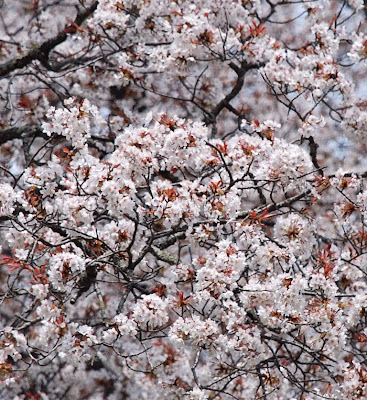YOGAI-ZAKURA
要害桜
広島県庄原市東城町小奴可
広島県庄原市東城町小奴可
The following write-up is my translation of the information board found on site.
This large cherry tree, a member of the ‘edohigan’ family in Japanese, is found on Kyushu, Shikoku and Honshu in Japan as well as in the southern part of the Korean Peninsula and central parts of China.
This cherry tree in particular was planted around 260 years ago on the site of what was the Kameyama Castle and known to the locals as ‘yogaizakura’. It has been well protected and cherished by the town folk ever since allowing it to grow into the giant it is today. Its trunk is 5.7 metres in girth and stands at a height of approximately 18 metres.
Yogaizakura is the largest of all the Hiroshima Prefecture designated cherry trees, noted for its magnificent features and beauty of its blossoms when it flowers in mid April each year. Yogaizakura is not only recognised for its size but also for the great significance its presence had with the locals and being deeply linked to their lives. From an academic point of view this tree is of great value.
CHIDORI BESHAKU YAMA-ZAKURA
千鳥別尺の山桜
広島県庄原市東城町千鳥
広島県庄原市東城町千鳥
The following write-up is my translation of the information board found on site.
The yamazakura tree as it is called in Japanese can be found on Shikoku, Honshu and Kyushu as well as in the southern parts of the Korean peninsula. It is commonly found in Hiroshima Prefecture. The young leaves of the yamazakura tree are usually a reddish brown colour and shoot out as the tree flowers, however, on this tree the young leaves are hardly tinged with red at the time of flowering. The different varieties of the yamazakura are strikingly vast and many are known, however it is still unknown which variety this tree in particular belongs to.
There are very few large yamazakura trees and in Japan there are only a handful of yamazakura trees where the girth exceeds 4.5m. In 1990, there were only 8 national and 7 prefecture designated yamazakura trees and as far as it is known, this is the largest one. Its trunk is 4.6 metres in girth and stands at a height of approximately 25 metres. In spite of the fact that this tree is old, it is rare for the trunk to remain this healthy without it hollowing out.
One the southern side of the tree is a small shrine sacred to the koujin (荒神)god and although little is known about the purpose of this tree, it is thought that the tree was planted as a religious symbol and that the site was a common place shared and used by the local population and believers of kojinshinko (荒神信仰) for events.





No comments:
Post a Comment